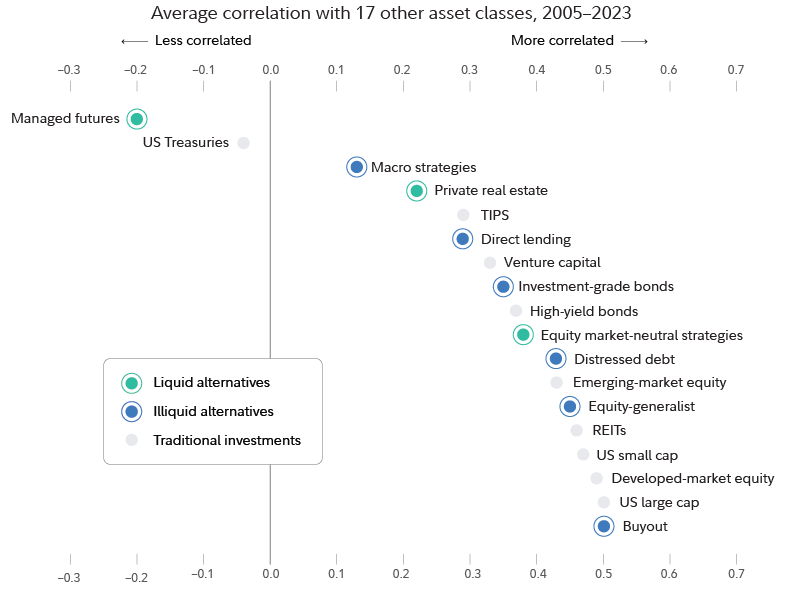You’re probably familiar with traditional investments, such as stocks, bonds, and cash. But how much do you know about alternative investments? Here’s a quick primer on alternatives and why you may want to think about adding some to your investment mix now.
What are alternatives?
You may see alternative investments referred to as “alternatives” or “alts.” If they sound foreign to you, rest assured that you may already be quite familiar with many alternative investment types. Real estate, gold, and bitcoin all fall under the umbrella of alternatives—which encompasses many investable assets beyond stocks, bonds, and cash-generating accounts.
Alternatives span a wide range of investments with varying characteristics, such as the ability to meet different investing goals, with unique risks and different degrees of liquidity (more on this later). They include hedge funds, private equity, private credit, real assets, digital assets, and liquid alt funds.
Why alternatives?
While alternatives share the feature of being nontraditional investments, each category has different characteristics—both when compared to traditional investments as well as to each other. In addition to the diversification benefits that alternatives can provide when integrated with a traditional investment mix, alternatives may also help enhance returns, manage risk, generate income, and/or protect against inflation.
- Expanded investment universe. Alternative investments can help investors expand beyond traditional asset classes, providing additional options to potentially grow and manage your money.
- Potentially enhanced returns or income. If one of your main investing objectives is to grow your money, research on alternatives has shown they can help enhance returns or generate income. Certain strategies may also help generate higher yields versus traditional asset classes, as they can benefit from regular interest payments from directly originated loans.

- Diversification benefits. Diversification across asset classes (in addition to diversification within asset classes) has been demonstrated to provide superior risk-adjusted returns. Alternatives can provide returns that differ from traditional investments. Diversification potential can be seen in the lower correlations that many alternatives have exhibited historically with traditional investments (and with each other). Correlation refers to how assets perform relative to one another (with lower correlations providing more diversification benefits). Of course, it’s worth noting that some alternatives have shorter track records than traditional investments—particularly relatively new alternative categories like digital assets—so there is not as much data to assess. With that said, recent data shows that correlations for alternatives are generally low with each other and with traditional investments.

- Potential to manage risk. Alternatives can lower the overall volatility of your investment mix through greater diversification. Additionally, they may help manage the risk of your overall investment mix. The chart below shows how alternatives have generally outperformed traditional investments when the Russell 1000 has had its worst performance.

- Potential to mitigate inflation. Some alternatives can help offset losses associated with inflation. In particular, private real estate has demonstrated a resistance to inflationary effects.
Why alternatives now?
Historically, institutional and wealthy investors have had access to alternatives. That’s primarily because these types of investors are generally not as constrained by liquidity needs when compared with individual investors. Liquidity refers to how easy it is to turn an asset into cash. Highly liquid assets (like stocks) are relatively easy to turn into cash, whereas illiquid assets (like many private market alternatives) can be difficult to turn into cash quickly.
But changes have been afoot in recent years, making it more possible for individual investors to consider alternatives.
The ability to invest in alternatives has expanded for individual investors. For example, there has been increasing development and access to private market alternative investments, including intermittent liquidity funds—such as unlisted business development companies, interval funds, and tender offer funds.
Another recent development has been the growing number of “liquid alternatives.” These include funds that invest in public market assets and/or derivatives, while implementing alternative strategies such as long/short investing that can help enhance returns, diversify, and provide risk mitigation to an overall portfolio.
The emergence of digital assets (e.g., cryptocurrencies) is another example. The newest alternative asset class has featured strong liquidity (at least for bitcoin, the world’s largest cryptocurrency by market cap) alongside historically outsized returns—albeit with significant price volatility.
Alternative investing
While most investors have familiarity with buying stocks and putting cash in accounts that generate interest, far fewer have experience investing in alternative investments. That may change in the coming years.
Investors who allocate some percentage of their investment mix to alternatives, rather than sticking solely with stocks and bonds, may be able to improve their long-term investment results.
Of course, investing in alternatives may not be right for everyone. They can be much more complex than traditional investments. Some have high minimum investments and long time horizons. For example, investing in illiquid alts can mean locking your money up for multiple years (a “lock-up” period is a predetermined time that the investor is not able to redeem their investment). Moreover, some alternatives can be volatile, and may not align with your investing objectives.
With that said, emerging assets and innovative new products are offering ways for more investors to get access to alternatives that may not have previously been possible. Depending on your specific goals, alternatives may be an opportunity worth considering.


